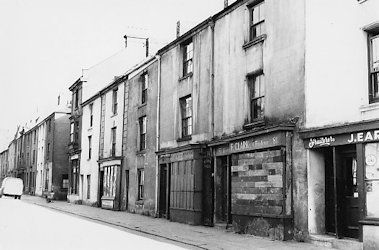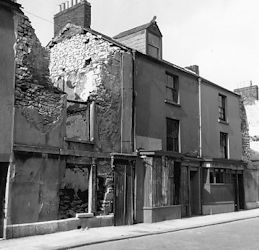|
OLD DEVONPORT
. UK |
||
|
© Brian
Moseley, Plymouth Webpage created: March 21, 2016 Webpage updated: May 29, 2021 |
||
|
ROADS AND STREETS IN OLD DEVONPORT PEMBROKE STREET Pembroke Street was in 1914 one of Devonport's principal streets, with a great number of retailers and public houses. It was said to have been built in what were previously known as Liberty Fields. The Street ran eastwards from James Street to George Square, numbers 1 to 56 being on the northern side and returning from George Square with numbers 57 to 109 on the southern side.
Numbers 76, on the corner with Stanley Street,
to number 82 Pembroke Street. The Street had many buildings of architectural interest but the principal ones were the Saint Mary's Mission Hall at number 89 and the Pembroke Street Baptist Chapel between numbers 98 and 99. Licensed Landmarks in 1914 included: the Royal Exchange (number 1, on the corner with James Street), the Guardship Inn (8), the George Inn (13), the Albion Hotel (18, on the corner with Canterbury Street), the Royal oak (28), the Jolly Bacchus (30), the Himalaya Inn (37, on the corner with Stanley Street), the Bristol Vaults (51), the Musketry Arms (56), and on the southern side of the Street, the Half Moon Hotel (59), the King's Arms Hotel (60), and the Rose and Crown (96, on the corner with Canterbury Street). There was also a beer retailer at number 41 (Mr W Baker). In the above photograph the shops were, from Stanley Street forward: Mr T White, newsagents; Mrs Emily Smith, dairy; Mr George Pitcher, butcher; and Mr Frederick Richard Clark, greengrocer. Mr John James Earl was the shop keeper at number 82 in 1951.
The two premises in the centre of this picture
were numbers 46 and 47 Pembroke Street, Devonport. Retail businesses included a branch of Messrs Eastman's Ltd, the butchers, plenty of general shops, a fish shop (Mr H Mullery), a haberdasher and a draper, a fancy goods store (Mrs Martin), a couple of tobacconists, the Oak Vale Dairy Company, and several bakers. On the corner with James Street, opposite the Royal Exchange, was the Post Office and stationers, Mr C D James.
It was a long walk to
the nearest tramway services, which were in Cumberland Road. |
||

